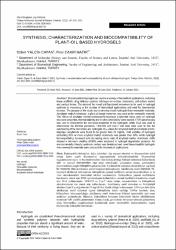| dc.contributor.author | Yalçın Çapan, Özlem | en_US |
| dc.contributor.author | Çakır Hatır, Pınar | en_US |
| dc.date.accessioned | 2021-11-16T15:30:45Z | |
| dc.date.available | 2021-11-16T15:30:45Z | |
| dc.date.issued | 2021 | en_US |
| dc.identifier.citation | ÇAPAN, Ö. Y., & HATİR, P. C. (2021). SYNTHESIS, CHARACTERIZATION AND BIOCOMPATIBILITY OF PLANT-OIL BASED HYDROGELS. Trakya University Journal of Natural Sciences. | en_US |
| dc.identifier.issn | 2147-0294 | |
| dc.identifier.issn | 2528-9691 | |
| dc.identifier.uri | https://doi.org/10.23902/trkjnat.925742 | |
| dc.identifier.uri | https://hdl.handle.net/20.500.12294/2888 | |
| dc.description.abstract | Biocompatible hydrogels are used in a variety of biomedical applications, including tissue scaffolds, drug delivery systems, lab/organ-on-a-chips, biosensors, cell-culture studies and contact lenses. The demand for novel and functional monomers to be used in hydrogel synthesis is increasing as the number of biomedical applications and need for biomaterials increase. The purpose of the study was to develop novel hydrogels from renewable materials. Acrylated methyl ricinoleate, a plant oil-based monomer, was used as the renewable material. The effects of acrylated methyl ricinoleate/N-isopropyl acrylamide molar ratio on hydrogel structural properties, thermal stability and in vitro cytotoxicity were studied. FTIR spectroscopy was used to characterize the structural properties of the hydrogels, while TGA was used to characterize the thermal properties. HEK293 and Cos-7 cell lines were used to test the cytotoxicity of the monomers and hydrogels. IC50 values for acrylated methyl ricinoleate and N-isopropyl acrylamide were found to be greater than 25 mg/mL. Cell viability of hydrogels containing 50% or more acrylated methyl ricinoleate was greater than 60%, while hydrogel biocompatibility decreased with decreasing molar ratio of acrylated methyl ricinoleate. Cells showed a minimum viability of 80% when incubated in hydrogel degradation products. An environmentally friendly synthesis method was developed and novel biocompatible hydrogels from renewable materials were produced for biomedical applications. | en_US |
| dc.language.iso | eng | en_US |
| dc.publisher | Trakya University | en_US |
| dc.relation.ispartof | Trakya University Journal of Natural Sciences | en_US |
| dc.identifier.doi | 10.23902/trkjnat.925742 | en_US |
| dc.identifier.doi | 10.23902/trkjnat.925742 | |
| dc.rights | info:eu-repo/semantics/openAccess | en_US |
| dc.subject | Hydrogel | en_US |
| dc.subject | Renewable Resources | en_US |
| dc.subject | Biocompatibility | en_US |
| dc.subject | Acrylated Methyl Ricinoleate | en_US |
| dc.title | Synthesis, Characterization and Biocompatibility Oo Plant-Oil Based Hydrogels | en_US |
| dc.type | article | en_US |
| dc.department | Fen-Edebiyat Fakültesi, Moleküler Biyoloji ve Genetik Bölümü | en_US |
| dc.authorid | 0000-0002-7511-3355 | en_US |
| dc.identifier.volume | 22 | en_US |
| dc.identifier.issue | 2 | en_US |
| dc.identifier.startpage | 147 | en_US |
| dc.identifier.endpage | 154 | en_US |
| dc.relation.publicationcategory | Makale - Uluslararası Hakemli Dergi - Kurum Öğretim Elemanı | en_US |


















